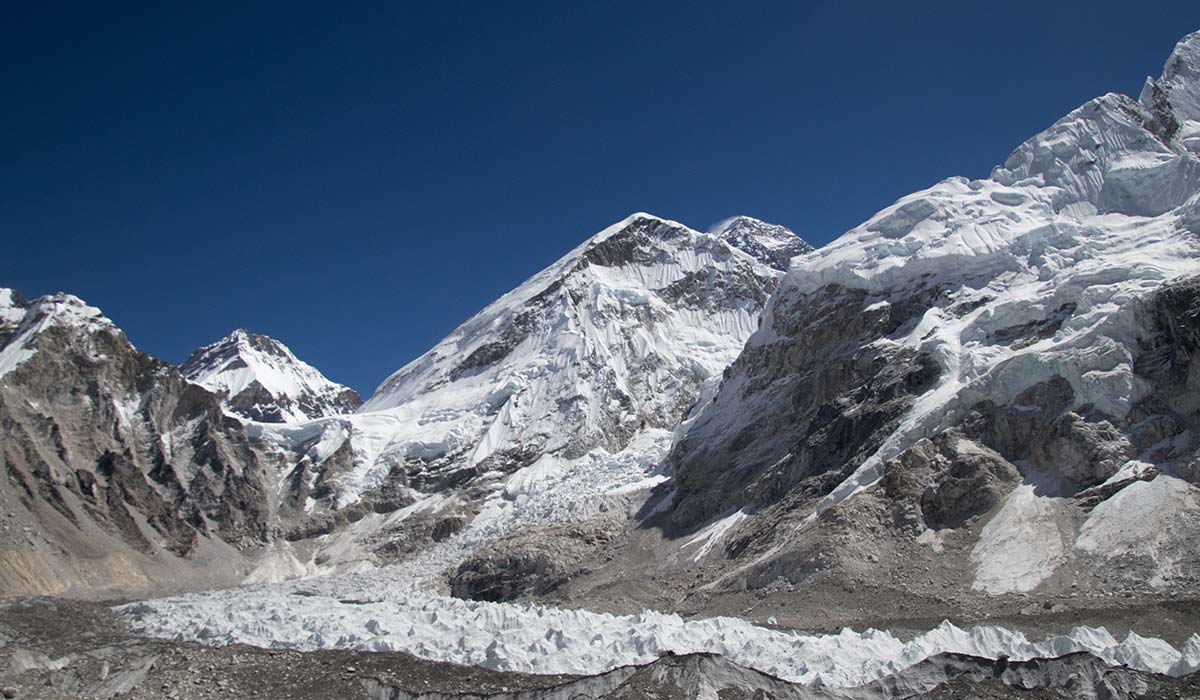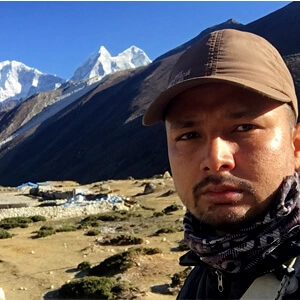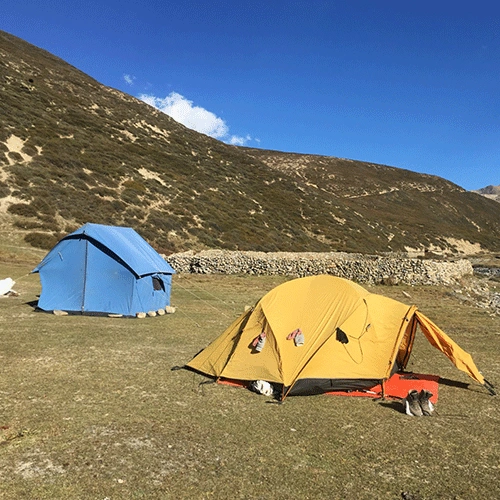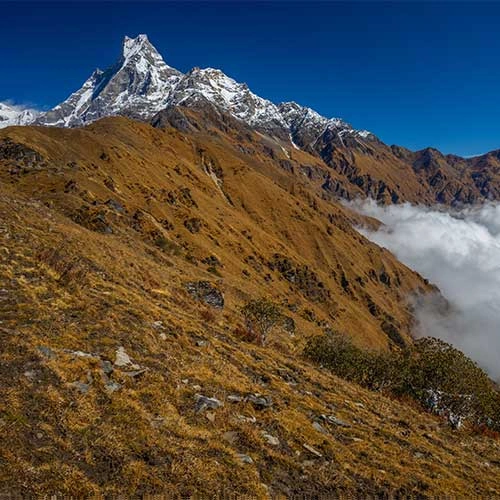Key highlights of the Everest Base Camp Trek
- Great Weather: March kicks off the trekking season with clear skies. Days are sunny, and nights are cool, making it perfect for trekking.
- Amazing Views: Clear skies in March reveal stunning views of Mount Everest and nearby peaks, ideal for capturing great photos.
- Fewer Crowds: Trails are less busy compared to April. You’ll enjoy a peaceful trek without feeling too isolated.
- Warm Sherpa Hospitality: Passing through villages like Namche Bazaar, you’ll experience the kind and welcoming Sherpa culture.
- Sagarmatha National Park: March is a wonderful time to explore this UNESCO site. Look out for wildlife like snow leopards and blooming rhododendron forests.
- Kala Patthar Sunrise: Watching the sunrise from Kala Patthar is unforgettable. The clear blue skies offer a stunning view of Everest and the surrounding peaks.
- Tengboche Monastery: This quiet monastery feels extra special in March. The Himalayan views around it add to the spiritual experience.
- Glaciers and Icefalls: The Khumbu Glacier and Icefall present themselves in full glory in the sun of March, making them much more magical.
- Perfect Trekking Conditions: Stable weather and manageable amounts of snow make navigating the trails easier.

Weather and Climate in March for EBC Trek
March is the transition period between winter and spring and is characterized by cool and pleasant weather during the Everest Base Camp trek. The daytime temperature fluctuates between 7°C and 17°C at lower altitudes. At night, temperatures at higher altitudes, like Everest Base Camp, can drop to -3°C or even -15°C. This means you’ll enjoy warm days but should prepare for cold evenings.
March often brings clear skies, which makes it an ideal time to enjoy the breathtaking Himalayan views. The air is dry, and rain is rare, though early March might bring light snow at higher altitudes. The snowfall makes the trek more beautiful and adds a sense of adventure.
Since March is before the monsoon, it’s smart to carry lightweight rain gear as a precaution. While rare, sudden rain showers can happen. The trails are less crowded than peak trekking months, offering a quieter experience. Accommodation is easier to find, ensuring a comfortable journey.
Permits Needed for the EBC Trek
When trekking to Everest Base Camp, getting the necessary permits is essential. These documents help keep trekkers safe and support the proper management of the region. They also protect its natural beauty.
- Trekkers’ Information Management System Card: Every trekker in Nepal must have this card. It helps track and manage trekking activities.
- Sagarmatha National Park Entry Permit: You’ll need this permit to enter the national park, which covers Everest and its surrounding areas.
- Local Area Permit / Khumbu Pasang Lhamu Rural Municipality Permit: This permit is necessary if you’re trekking through the Khumbu region.
You can easily obtain these permits in Kathmandu or at the trekking region's entry points. The permits are accessible throughout the trek. It may be checked at various points to help organize your permits early and confirm all requirements before setting off. Once everything is ready, your journey to Everest Base Camp will be smooth, safe, and truly unforgettable.
Preparing for Altitude in the EBC
Preparing for the Everest Base Camp (EBC) trek is preparing your body for high altitudes. Acclimatizing to thinner air is crucial for a safe and successful journey.
- Start Early: Begin at least two to three months before the trek. Include jogging, cycling, or swimming to build stamina. Start by slowly increasing the intensity of your workouts to help your body adjust.
- Pre-Acclimatization: Spending time at higher elevations before a trek enables your body to adapt. If you don't have such a facility, altitude simulation devices are used or fitted, and a training mask and tent simulate altitude by controlling low oxygen.
- Hike at Elevation: Practice hiking in upward regions around your proximity. Keep emphasizing the long, steady ones for general stamina gain and conditions resembling treks to acclimatize more easily while walking continuously at heights for many hours.
- Hydration and Nutrition: Keep your body hydrated throughout the preparation and trek. Drink plenty of water each day. Eat a balanced diet with carbohydrates and proteins to give your body energy.
- Rest and Recovery: Get enough sleep and allow your body to recover after each tough training session. Rest is as important as exercise in preparation for altitude.
Fitness and Training for EBC
You must prepare for the Everest Base Camp (EBC) trek in March, which requires good physical fitness and careful training. The trek includes long days of walking at high altitudes, which helps build a strong foundation. Start training at least three months before the trek to give your body enough time to adjust.
You can focus on both aerobic and strength exercises. Hiking with a backpack, brisk walking, and running will improve your cardiovascular endurance. Strength training is also important, and it should include exercises like squats, lunges, and core workouts to strengthen your legs and core. Try to get 30 minutes of cardio, three to five times a week. Gradually, it increases the intensity and duration as you progress.
It’s important to manage fatigue during your training if you feel tired. Drink water regularly and practice carrying a loaded backpack on different terrains. This will help you adjust to the weight and uneven paths.
When you begin the trek, start at a slow pace. It gives your body time to adjust to the altitude. You can use trekking poles for balance and support, especially during steep descents. It can help prevent strain. You can take advantage of rest days to recover and recharge for the next stages of your journey. The EBC trek can be a rewarding and enjoyable adventure with the right preparation and mindset.
Packing Essentials for March
Packing the right things for EBC in March is significant to comfort and safety. This month is partly spring and partly early monsoon, which makes the conditions quite unpredictable. It would be very helpful to wear your clothes in layers to keep warm during chilly mornings and evenings while staying cool on sunny days.
Begin with base layers that will keep the moisture away. Add a warm fleece or down jacket for chilly times and a waterproof, windproof jacket to handle unexpected rain or snow. Further, add a hat, gloves, and scarf to protect against cold winds. For the warm parts of the day, breathable shirts and light pants will be comfortable. Sturdy, waterproof trekking boots with warm socks will be necessary to keep your feet from cold and wet conditions.
You will also need the essential equipment: a good quality backpack with a rain cover, a cold-weather sleeping bag, and trekking poles for added balance. A headlamp with extra batteries is also needed for cases of early starts or late finishes. Similarly, pack personal hygiene items such as hand sanitizer and wet wipes, including a basic first-aid kit.
Finally, prepare the emergency kit for yourself. You can carry a whistle, portable power bank, or water filter. The key in emergent situations may lie with these small things. Packing wisely will help you to enjoy the trek and counter any bad contingency.
Flights back and forth from Lukla
Booking flights to Lukla for the EBC trek requires some careful planning. It's important to choose your flight dates early to secure a seat. March is the spring trekking season, so booking your flights well in advance is important. During this time, flight demand increases, and seats can fill quickly. Always double-check the airline's cancellation and rescheduling policies. Mountain weather can change quickly, causing flight delays or cancellations.
Weather-related delays are common when flying to Lukla. March brings clearer skies, but the weather can still be unpredictable. Poor visibility, high winds, or snow may disrupt flights. It is a good idea to allow extra days in your itinerary so you don't feel rushed. This gives you a buffer to accommodate delays and enough time to start your trek.
The other way to EBC, if flying is not an option or you are looking for something more adventurous, would be to trek in via Jiri or Phaplu. These options give a great local cultural feel and outstanding landscapes. The longer route from Jiri allows for great acclimatization, which can be useful for first-time trekkers. Alternatively, the shorter route from Phaplu also offers great mountain views.
Trekking with Guides and Porters
Trekking to Everest Base Camp in March is an exciting adventure. It becomes even better when you hire guides and porters to help along the way.
Certain key reasons behind hiring guides and porters include the fact that they would have experience in negotiating the rough terrain of their native country, with knowledge of providing safety and comfort. They carry heavy loads, freeing you to enjoy the view without the weight of a heavy backpack.
The cost and tipping are usually a guide costs $25 to $30 per day and porters $15 to $20 per day. It is always good to give your guides and porters tips at the end of the trek, and it's considered that this amount should be 10 to 15% of the total cost of your trek. This is a wonderful way to show appreciation for their hard work and dedication.
Choose a reliable agency with good reviews and experience in the field, which assures their reliability when choosing a trekking agency. Ensure that the guides and porters are adequately insured and show safety concerns. It should also have a clear cancellation policy and transparent pricing.
The EBC trek in March is beautiful, along with making informed choices to enhance the journey. With the right support from guides and porters, you can fully give in to this unforgettable experience while ensuring a smooth trek through the majestic Himalayas.
Connectivity and Charging Options
During a trek on Everest, especially in March, connectivity is vital in case of emergencies and sharing the experience. Generally, there is good mobile network coverage along the trail, at least in some stops like Namche Bazaar and Dingboche. Here, most trekkers can access 3G services to make calls and share updates on social media. However, as you go higher, coverage may become limited, so it’s a good idea to inform family or friends about your route before you head out.
Along with mobile services, Wi-Fi availability is another consideration. Many teahouses along the trail offer Wi-Fi, which may be slow or unreliable. It’s good to check the connection quality before depending on it for important messages.
You can get charging facilities in teahouses, but it often comes for a price. So, having a power bank is highly recommended. A 20,000 mAh+ power bank would suffice to charge all your gadgets throughout the trek. For longer expeditions, do carry a solar charger, preferably lightweight.
With the help of a multiport charger, you can keep multiple devices charged to stay connected during the trek. This way, you can enjoy the Himalayan views without worrying about your battery running out. Always charge in advance and remain in touch during your EBC trek.
Health and Safety Tips
Health and safety should be your top priority when trekking to EBC in March. You must be updated on routine vaccines before traveling to Nepal. It is highly recommended that vaccinations include Hepatitis A, Typhoid, and Tetanus. Based on the travel plans, consider additional vaccines like Rabies and Japanese Encephalitis, especially if you spend extended time outdoors or in rural areas.
Speaking with a healthcare provider for advice tailored to your needs is important. It is very beneficial for travel insurance, especially for high-altitude trekking. The insurance should include coverage for rescue and evacuation above 5,000 meters, as emergencies can happen unexpectedly. Keep a copy of your insurance details with you on the trek. This will help you access services if needed.
While trekking in remote areas, you must know that clinics and rescue services are available. It is quite comforting. Guides are trained to spot signs of altitude sickness and can quickly get medical help if needed. Familiarize yourself with the nearest clinics along your route and understand the protocols for emergency evacuations. A small first aid kit with basic medications can help improve your preparedness.
Sherpa Traditions and Local Customs
Understanding Sherpa culture during the EBC trek adds value to your overall local customs. The Sherpa people relate strongly to the mountains, following traditions under Buddhism. If one respects their customs, it will be a positive and respectful experience in the Everest Region.
While trekking, you’ll encounter many religious sites, such as monasteries and stupas. It’s essential to show proper respect here. Always walk clockwise around these sites, which is considered respectful in the Buddhist tradition. When entering a monastery, remove your hat and sunglasses. You might also be asked to make a small donation, which would be greatly appreciated.
Remember that the Sherpa people are friendly and welcoming when engaging with locals. However, it’s important to engage with respect. Greet them with a simple “Namaste” and smile. Always ask for permission before taking photos, especially of people. Avoid entering private spaces without consent. Be courteous and appreciative if invited into someone’s home or a teahouse.
You contribute to a positive and meaningful cultural exchange by respecting Sherpa traditions and local etiquette. It helps build stronger bonds with the community, making your EBC trek a physical and cultural journey.

Emergency Procedures
In case of altitude sickness or injury during the EBC trek, acting quickly is important. Symptoms of altitude sickness include headaches, dizziness and nausea. If you feel any of these, it’s essential to stop and rest. If your symptoms get worse, go down to a lower altitude. Remember to pre-inform your guide as they are trained to handle such situations smoothly.
In case of any injury, you can seek immediate assistance from your guide or fellow trekkers. Similarly, you can go for a helicopter evacuation, which is available for serious injuries. This is true for areas like Lukla or Namche Bazaar, where helicopter evacuations can be expensive. The cost typically varies from $2,000 to $5,000, depending on the location and how serious the situation is. Therefore, it's important to have travel insurance that covers both evacuation and medical expenses.
To contact rescue services, use your mobile phone or ask local teahouses for help. Most places have access to communication services. It’s also crucial to have your insurance provider’s contact information handy. Ensure your insurance policy covers emergencies in high-altitude regions. Preparing for emergencies helps keep you safe and gives you peace of mind during the trek.
Conclusion: Why March is a Great Time for the Everest Base Camp Trek?
When trekking in the Himalayas, it's important to have travel insurance that covers emergency evacuation, medical treatment, and trip cancellation. Ensure your policy covers high-altitude activities above 3,000 meters and any trekking-related incidents. This is essential for peace of mind during the trek. This is especially true when you deal with unpredictable conditions.
Altitude sickness is a common concern for trekkers above 2,500 meters, particularly on high-altitude treks like Everest Base Camp. Symptoms include headaches, nausea, dizziness, and shortness of breath. Acclimatization is key to reducing the risk. Gradually adjust to higher elevations, drink plenty of water, avoid alcohol, and take adequate rest. If symptoms worsen, descending to a lower altitude immediately is important.
In an emergency, such as altitude sickness or injury, helicopter evacuation is available, but it can be expensive. It’s advisable to trek with a guide trained in first aid and to notify them of any health conditions beforehand. To maintain personal health, stay hydrated, eat nutritious meals, and avoid caffeine or alcohol. Regular breaks will help you manage fatigue and ensure a safer trek to Everest Base Camp in March.






